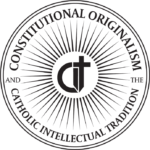One of the challenging features of interpreting Professor Adrian Vermeule’s Common Good Constitutionalism that Jeff Pojanowski and I encountered in Recovering Classical Legal Constitutionalism was to assess the extent to which Vermeule’s book is best read esoterically. We decided to respond to the exoteric argumentation on its own terms while also suggesting what we understood to be the main esoteric message. The book, we think, is best understood not as offering guidance for how to operate within and maintain the existing constitutional order in the United States of America that remains tethered to the promulgated Constitution, but rather as a way of facilitating regime change to a different constitutional order. We wrote:
Vermeule’s highly abstract notion of continuity with the original Constitution and its order suggests that he may be more interested in laying the theoretical foundation for a new order than in identifying the law of this one. All told, the book seems less a classical approach to our actual Constitution than a permission structure for a new and improved constitutional order. In this respect, the best reading of Vermeule’s two-level approach in Common Good Constitutionalism is one between the lines.
98 Notre Dame L. Rev. at 460 (emphasis added).
Our citation here was to Arthur M. Melzer, Philosophy Between the Lines: The Lost History of Esoteric Writing (Univ. of Chicago Press 2014).
As an example of a between-the-lines reading, we highlighted continuities between Vermeule’s decision-theoretic textualism in earlier writing and his “presumptive textualism” in Common Good Constitutionalism. We wrote:
The Vermeule of Judging Under Uncertainty did not embrace the idea that interpretation is something like the search for the reasoned ordinance of an actual legislator; rather, he claimed that philosophical arguments about the point of legal interpretation are pointless. This presumptive textualism is a “firmly [rule] consequentialist” exercise in decision-theoretic “interpretive choice.” Though we assume Vermeule, now a classical natural lawyer, is not a rule-consequentialist all the way down, his presumptive textualism still bears the mark of the public-choice inflected method of his earlier adherence to decision theory. Judges are better off if they “stick to the ordinary meanings of texts” (also phrased as “apparent meaning[s]”) since judges are “prone to error.” The classical tradition, by contrast, treats the text as a (very important, but not exclusive) pointer to the legislator’s authoritative, reasoned choice, which in its particularity may be different or more complex than what we find with some exercises of clause-bound textualism.
The extent to which Vermeule believes he has adhered to or departed from his earlier approach to interpretation is beside the point. Something very much like the surface-level, clause-bound textualism of that earlier work enables his ascent to moral readings in response to apparent ambiguity or vagueness that interpreters find when they read text in that fashion. After all, these “highly general and abstract clauses have to be given some content or other.” In Judging Under Uncertainty, judges were not to solve such puzzles with the wide-ranging tools that classical lawyers (and modern textualists and purposivists) use, but rather defer to bodies like administrative agencies or legislatures. Reading between the lines, one sees in Vermeule’s generic account of common good constitutionalism a way forward to a regime in which centralized agencies are the living oracles of the natural law and the common good. Vermeule draws such a picture in the particular “Applications” section of his book. The surface-hugging, clause-bound character of presumptive textualism is crucial for realizing that arrangement, however, since a more detailed search to find the Framers’ reasoned choice may correspondingly limit the remit of agencies (or, if you prefer, legislators) to give some content ordering law to the common good.
98 Notre Dame L. Rev. at 426-47 (emphasis added).
Vermeule contends that what he calls his “classical textualism” “rests … on an institutional claim: for a certain class of decision-makers, under given circumstances, certain goods are best attained by requiring those decision-makers to stick closely to the ordinary, conventional meaning of text.” Instead of understanding the role of text by means of decision theory and a Dworkinian understanding of law, as the Vermeulean interpreter would, Pojanowski and I have argued for understanding legal texts as a material cause of the promulgated law. This metaphysical perspective provides a sounder foundation for the classical legal interpreter, in our view, than decision-theoretic Dworkinianism. A sounder foundation, that is, for continuing to operate within the order we have rather than the one Vermeule aims to midwife.

